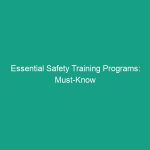Introduction
Good morning team! Today, we’re diving into a vital topic that affects each one of us: Must-Know Vehicle Safety Guidelines. As many of you drive vehicles as part of your daily work, understanding these guidelines is essential for ensuring our Safety and well-being on the road.
Vehicle Safety is not just a set of rules; it’s about protecting our lives and the lives of those around us. Ignoring safety protocols can lead to serious accidents, injuries, and even fatalities. So let’s learn how we can mitigate risks and create a safer work Environment.
Understanding Vehicle Safety Guidelines
Vehicle safety guidelines encompass the practices and protocols that help ensure the safe Operation of vehicles. These guidelines are particularly important in the workplace, where employees may be required to drive for deliveries, site visits, or other job-related tasks.
Many employees may think that vehicle safety is only about wearing seatbelts or following traffic signals. While these are crucial, vehicle safety also includes vehicle Maintenance, awareness of surroundings, and understanding the impacts of fatigue and distractions while driving.
Key Hazards, Risks, and Safety Considerations
When it comes to vehicle safety, there are several Hazards and risks that we must be aware of:
- Distracted Driving: Engaging in activities such as texting, eating, or adjusting the radio while driving significantly increases the risk of accidents.
- Fatigue: Driving while tired can impair judgment and reaction times, leading to dangerous situations on the road.
- Vehicle Maintenance: Failure to maintain vehicles can result in mechanical failures, which can cause accidents or breakdowns.
- Weather Conditions: Poor weather conditions like rain, snow, or fog can reduce visibility and traction, increasing the risk of accidents.
- Speeding: Driving over the speed limit or too fast for conditions can lead to loss of control and increased severity of accidents.
Real-world consequences of ignoring these safety practices can be severe. For instance, distracted driving accounted for 9% of fatal crashes in 2019, resulting in thousands of deaths. It’s crucial to recognize the impact of our actions on Road Safety.
Best Practices, Procedures, & Actionable Advice
To enhance vehicle safety, here are some Best Practices everyone should follow:
1. Conduct Pre-Trip Inspections
Before you start driving, perform a quick inspection of the vehicle. Check the lights, brakes, tires, and fluid levels. This can help catch potential issues before they lead to accidents.
2. Eliminate Distractions
Keep your focus on the road. Avoid using your phone, eating, or engaging in any activity that takes your attention away from driving.
3. Prioritize Rest
If you’re feeling tired, take a break. Fatigue can significantly impair your driving ability. If necessary, consider carpooling or scheduling longer trips with adequate breaks.
4. Adjust to Weather Conditions
In adverse weather, reduce your speed and increase your following distance. Use headlights in low visibility conditions and ensure your windshield wipers are functional.
5. Follow Traffic Laws
Always obey traffic signals, speed limits, and road signs. These rules are in place to protect you and others on the road.
Let’s consider a real-world incident: a delivery driver was involved in an accident due to a blown tire. The driver had ignored routine maintenance checks, and the vehicle was not roadworthy. This incident could have been avoided with proper vehicle checks and maintenance practices.
Regulations, Standards, and Compliance
Adhering to vehicle safety guidelines is not just a best practice; it’s often a legal requirement. Regulations set forth by OSHA and the Department of Transportation (DOT) mandate certain safety Standards that must be followed to ensure employee safety.
Compliance with these Regulations helps protect employees from accidents and injuries while also safeguarding the company from legal liabilities. Regular Training on vehicle safety and adherence to maintenance schedules are critical elements of compliance.
Employee Engagement & Discussion
Now, let’s open the floor for discussion. What safety challenges have you encountered related to vehicle operation? Have you noticed any unsafe behaviors among peers? How can we better support each other in maintaining vehicle safety?
Sharing experiences can greatly enhance our understanding of vehicle safety and help us develop practical solutions together.
Conclusion & Key Takeaways
In summary, understanding and implementing vehicle safety guidelines is paramount for everyone’s safety on the road. By recognizing the hazards, following Best Practices, and complying with regulations, we can significantly reduce risks associated with vehicle operations.
Remember, safety isn’t just a priority; it’s a commitment we make to ourselves and each other. Thank you all for your attention today. Let’s prioritize safety and make it a part of our daily routines!


